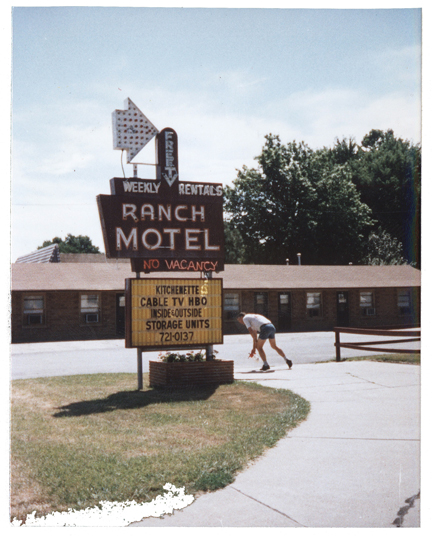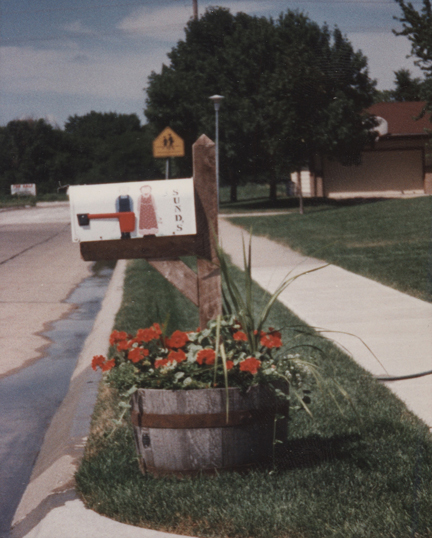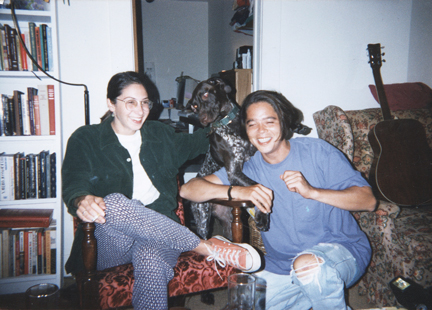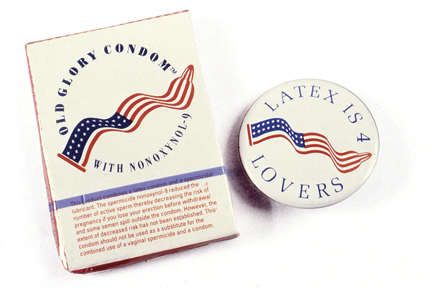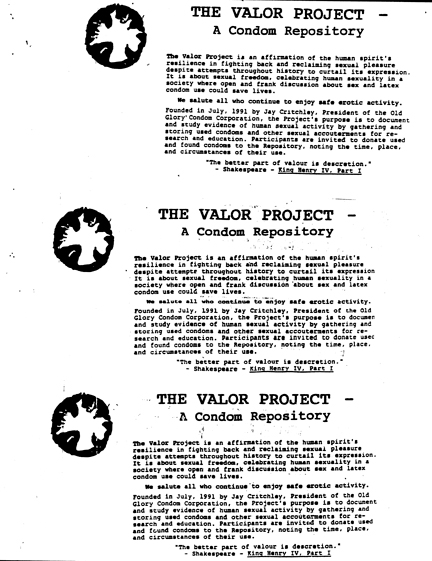An Address
Sunday, September 10th, 2017INDIVIDUAL: Peter Miles Bergman
GROUP SIZE: 11
NATURE OF GROUP: Residents of 10 addresses in Freemont, Nebraska and 10 addresses in Newport, Rhode Island, selected at random from a collection of phone books on microfiche, who happened to be home when we showed up at their door
INCIDENCE: An Address
An Address from Institute of Sociometry
Though this is one of IS’s oldest reports, it has, until now, only existed in the form of this 36-minute VHS documentary, produced by Peter Miles Bergman and directed by Siri Noel Wilson in 1995.
In 1993 the Geisel Library at the University of California San Diego, named after Dr. Seuss and famous for its cameo as the spaceship in Close Encounters of the Third Kind, had one of every city and town’s phone books in the US on microfiche. Reaching blindly into the library catalog drawer of phone book microfiche films, name out of a hat style, I plucked a microfiche for Freemont, Nebraska and one for Newport, Rhode Island, both towns that appeared to be in the 20,000-30,000 population range, and wrote down the first 10 names and addresses in each that caught my eye.

DUPLICATE – Two years of postcards, letters and Christmas cards
On a subsequent trip to Europe to visit agent 002 Siri Noel Wilson, I wrote postcards to the residents at each of these 20 addresses – from Bologna, Italy; Paris, France; Amsterdam, The Netherlands; and, when I returned to the US, from San Diego, California. I signed each card with my name and mentioned that I lived in San Diego, but I did not provide a return address. Each time I wrote the cards, I did so in one sitting and in the order of the addresses on my list. By the fifth postcard, I’d usually lost sight of the actual human on the receiving end and was essentially writing to the faceless and hypothetical audience I’d assumed would be enthralled by my puerile art prank. Each batch of cards followed the same arc. The first few were awkward but sincere, the next few were fluid and confident, halfway through they became a little sarcastic, toward the end the tone was wholly flippant or abstract, and I closed out the 20 with a few that were poignant and contemplative. Here’s an excerpt: “Hi Wayne! Hi Vicky, I have returned from my travels. That’s a little bit of Euro snobbery I picked up. Really though, I’m going back. It all went by way too fast. In fact, there are whole blocks of time I don’t remember a thing…”
Over the next two years I followed up with homemade Christmas cards and long-form handwritten letters (click to enlarge):
Excerpt: “Hello Mr. John Brooks. This is Peter M. Bergman. I am attempting to take our friendship to the next level by writing you this letter… Some days I want everything to make sense on earth. I want all my activities to mean something. Days like today I realize how dumb that is. So if this doesn’t make sense then it must not be dumb. Does that make sense? … Do you know what entropy is? Entropy is the measure of disorder in a closed system. Entropy always increases and available energy always decreases in a closed system – such as our universe. Isn’t that neat? … I think you getting these letters from me is a sort of disorder in your life. But it’s good because now we are friends! To get your name and address I just picked a phone book from the library and viola! … I think I’m going to have ‘Evidence of Entropy’ on my tombstone. It’s good to think of these things now you know. You never can tell when that sneaky ol’ entropy is going to mess with you!”
In the spring of 1994 all of the addressees on my list received a postcard written in Sharpie with some form of, “Good news! Siri and I are coming out to visit you this summer!”
This “Ariel view of Mission Bay with Sea World” postcard (and 19 other in this tranche) notified Thelma and all the other recipients in Freemont, NE and Newport RI on our impending visit.
Freemont, Nebraska highlights:
Siri and I had no idea what we had gotten into as our Greyhound bus pulled into Freemont, but we were thoroughly prepared to document it with a micro-cassette recorder, 110 film camera, and Siri’s two super-8 movie cameras – one with sound! After we got situated at the Ranch Motel, a motor lodge across the highway from the bus station, we found a phone book with a town history. Named after General John C. Frémont, “The Pathfinder,” Freemont was a Mormon Trail stop, then a Telegraph town, then a railroad town, a highway town, and ultimately a bedroom community for people working 35 miles away in Omaha. The phone book also had a map, which we used to begin charting out our visits.
Our “Weekly Rental” – The Ranch Motel in Freemont
Our first visit was to Thelma Surface. Thelma lived in Nye Square, a retirement community with the slogan, “Be In Charge of your Life.” This was the first of many unexpected hurdles in our quest for immediate and authentic face-to-face encounters. The receptionist seemed to be on the lookout for us, explaining her trepidation about our visit since Thelma was living in a place where she was protected from “people on the outside.” After asking us a long series of suspicious questions, she buzzed Thelma’s room. Thelma hesitantly came out to greet us, right around the time the Freemont police showed up. We all had a pleasant conversation in the lobby area of the retirement community about Freemont and the social norms and customs that Siri and I didn’t quite seem to understand. The police, after ascertaining that we were no more harmful than the typical idiotic twenty-something Californians, offered us a ride back to our hotel – which we declined.
The next day we asked directions from, and subsequently made friends with Brent Harnish, a home-for-summer long-haired college kid close to our age who was happy to drive us around during the rest of our stay, hang out with us, and generally praise us as the only cool thing to happen all summer.
The home of Wayne E. and Vicky Sund in Freemont
Wayne E. Sund, who lived on the edge of town in a subdivision, was in front of his house washing his car and his boat. When we walked up the drive and introduced ourselves he chuckled with a subtle no-no-no head motion, strode forward and shook our hands. When we asked him about his reaction to the cards and letters he said, “After a while I thought, well you know… If I KNEW when he was coming I’d have my 12-guage at the back door. But apparently he’s harmless. I don’t know, I don’t KNOW! It was like, who the HELL is this?” Wayne was a funny guy who appreciated the random nature of our encounter. He had his young kids come out to meet us in a “you’ll want to remember this day so I can tell you this story over-and-over as you age” kind of way.
Wayne Sund – in retrospect our visit to Wayne was a highlight of the early 90’s for IS. In many ways it has never quite worked out as intended in such spectacular fashion since.
The young woman who answered Kathy Sherman’s door told us that Kathy was home, unhesitatingly invited us in, and announced in a super excited loud voice that Kathy had visitors. We guessed that our greeter had Down syndrome. Another roommate, also with Down syndrome, came out of the back room. We figured out quickly that it was a group home. We put away our camera. When Kathy came down the stairs her roommates clapped and cheered. She was beaming. Though we were naïve and inexperienced as documentarians, we did understand that this situation had transcended the authenticity we were seeking and had the potential to go straight to exploitation. Though Kathy was very excited to have us visit, she had zero recollection of ever having received any mail from us. I’m sure the cards and letters did make it to her, but on the afternoon we visited, she wasn’t able to connect me to the cards, which I had sent several months to a couple of years prior to our visit. It didn’t matter. We had a great time visiting and talking about life in the group home, about Freemont, who we were, and where we were from. There was never a question about why we came to visit. Reflecting on the experience outside, I had the first inkling of my own boundaries when working with real live people as an art medium. Siri and I could have easily filmed our entire visit to the group home, and even received verbal consent on camera, but that consent could not have been anything more than a technical acquiescence to be filmed. Aware that the group home residents did not understand that our project was a prank and that their names and images could be used for decades to make people laugh and scratch their heads, we determined that there was no ethical way to use any footage. More importantly, the moment was so genuinely human that worrying about capturing it would have simply distracted us from living it.
George O. Suydan wasn’t home. When we explained to the bewildered woman who answered the door that we were Pete and Siri and had been sending mail to George she lit up and exclaimed, “Oh Bergman! Yea! I’m his daughter in law. Nice to meet you after all this time. I’ve seen you in the pictures. Dad goes ‘WHO IS THIS’ and I said, ‘I don’t know, somebody friendly!’ He really appreciated and got a kick out of all the cards you sent!” Over lemonade on the porch, she told us George unfortunately had been relocated into an assisted living facility in Omaha. When we offered to start writing to him at his new address she replied, sadly, “He’s not all himself.”
Felix Unger’s son answered the door and went to get him.
“Hi! I’m Pete and this is Siri.”
“Oh yeah?”
“We’re the one’s who’ve been sending you postcards.”
“You the one sending postcards? Oh yeah? What are you guys doing here?”
“We’re just breezing through town and thought we’d visit and say hi.”
“Oh yeah?” (chuckles) “Well that’s weird ‘cause I was wondering where they were coming from. You know I get these in the mail and you don’t know what’s going on so basically I file 13 most of ‘em”
I’d given each recipient the name of someone else in their town I was writing to. I’d given Felix John Vecerra’s name – as it turns out someone he saw every day at work. “I talked to John Vecerra yesterday at work, or on Friday. When you said on the last one about your vacation to talk to John Vecerra. So I went and asked him. He said ‘I don’t know the guy either!”
The only piece of correspondence with a drawing – sent to John Vecerra of Freemont.
We caught up with John when he was on the way out of his apartment. When we introduced ourselves as Pete and Siri, the people who’d been writing him postcards, he seemed apprehensive. “Oh yeah? That was you? How did you pick me?”
“Out of the phone book. We picked ten people out of the Freemont phone book.”
“Oh yeah? What was the reason for that?”
“Just, I don’t know… To meet some different people…”
He invited us to breakfast the next morning at McDonald’s out on the highway. Over Egg McMuffins that John described as “not too exciting, but a way to start the day,” he told us about some area history and labor politics at the Hormel Factory where he worked with Felix Unger and was high up in the union.
John Vecerra outside of his address.
Scott Strouf’s house was about a mile out of town, but he wasn’t home. Riding back in the bed of a farm truck we’d hitched a ride from, Siri and I reflected on our visits. A few of them hadn’t panned out. People were no longer living at the addresses on my list or no one answered. The phone book on microfiche I’d grabbed may have been outdated. The addresses that were good, however, were really REALLY good. The people of Freemont had been openminded and either glad to meet us or very good at masking their anxiety.
Freemont Nebraska – Summer Crazy Days!
Newport, Rhode Island lowlights:
We did have one highlight in Newport. One of our first encounters was with a young couple, David and his girlfriend “Sweets,” who lived in an apartment building previously occupied by David Del Nero, who we had been writing to. After some confusion about having the same first name as our addressee, they became intrigued by our explanation of why we were lugging film cameras around Newport knocking on strangers’ doors and invited us back for dinner. Later that night in their apartment, David predicted we wouldn’t have as much luck in Newport as we reported having in Freemont. David described Newport as “pretty, but kind of a blue velvet pretty.” It is a town inhabited by a transient population of second home owning vacationers, Navy sailors and rotating faculty at the Naval War College, tribal New England fisherman, and the mega rich.
A case of mistaken identity! Dave and Sweets of Newport.
Newport was home to the monumental summer mansions of the Vanderbilts and other agriculture, railroad, and banking barons of the 19th century. Though life in the mid-1990s was considerably less opulent, many of Newport’s residents were still quite well-off, biding their time between Newport, New York or Boston apartments, and their boats. They were still heavily vested, philosophically if not outright financially, in a patrician East Coast class system.
Most of the addresses in Newport that were on our list were no longer inhabited by any occupants I’d written to. After a couple of days knocking on the doors of current inhabitants, ignorant of, or having purchased the home from, our addressees, we clued in that the Geisel Library’s phone books on microfiche were over a year out of date. We knocked on Ruth Erickson’s door, but it appeared to be an uninhabited house. Disappointed but resigned, we moved on.
Later that afternoon we caught up with Wilfred J. Buckley Jr., a fifty-something man who was out painting his porch. Wilfred had received some of the most sincere letters. Here’s an excerpt, “Wilfred, I want to share something with you. I want you to get a glimpse of what I’m like and have it make you happy. I want you to smile when you get a letter from me. That’s all I want. Sometimes, however I think people are just afraid of things like letters from strangers. I guess that’s just how it is…”
Wilfred Buckley Jr. of Freemont – a circa 1995 video still of a 110 photo reshot on a copy stand and then photographed while playing on a television of someone who never wanted their picture taken in the first place!
“Are you Wilfred?”
“Yeah”
“Hi, I’m Pete and this is Siri. We’re the people who’ve been writing you those you postcards.”
“What was that all about?”
“Just for fun, kinda’.”
“You know you scared the hell out of a little old lady! Ruth Erickson? She’s about 85 years old and she got so damn scared with the cards that she moved out of her house and moved in with her daughter.”
“Really? Oh NO!?”
“Yes! And the daughter has gone to the police about it.”
“Well that’s certainly not what we intended.”
“Well I don’t know what you intended but it was strange and that’s what happened.”
“Did they upset you?”
“Uh, I really didn’t know what the hell they were doing and they upset me because up until August 1st I was on the road. My job put me on the road quite a bit and I would leave my wife here. She didn’t know what the hell to make of it.”
“Well we didn’t know…”
“Well… That’s… Doing it to a 20-year-old couple is different than doing it to an 80-year-old lady.”
“We had no idea, that’s why.”
“I didn’t particularly care for them to be very truthful.”
“We didn’t say anything threatening, or anything”
“No, they really weren’t that friendly either. They were kind of strange cards. In fact we still have the cards and letters in the house. That Christmas card you sent was kind of weird.”
“That’s too bad it was taken the wrong way but…”
“Well, I’m serious you had that woman really, really upset.”
Though Wilfred was hostile, he was measured. He didn’t threaten us, he scolded us – and rightly so. We packed up the next day and silently boarded the Greyhound out of town.
The East Coast in a nutshell.
There is a time in the life of every antisocial, sarcastic, and angry young art punk when they reach this fork in the road. If they’re sober enough to make an informed decision, they can choose the right path by reflecting on the actual humans their shenanigans have targeted and avoid the path of nihilism and a life-long war on the happiness of everyone around them, and lastly but most importantly, themselves.
Though late 20th-century American ‘society’ deserved a good deconstructing, the unsuspecting individual civilians who comprised it did not deserve to have their lives upended for simply being listed in the phone book. Learning about Ruth Erikson’s reaction to my cards and letters caused me to realize, albeit a bit too late, that the unwritten rules of the art/life symbiosis dictate that it’s not appropriate to antagonize someone for artistic value if they themselves have not thrown some chips into the game… After the visit, I never sent another card or letter to anyone from Freemont or Newport.
—–
A version of An Address premiered at Sociometry Fair ‘96. The final edit, a 36-minute VHS documentary, produced by Peter Miles Bergman and directed by Siri Noel Wilson in 1996 (available at the top of this report) won Best Documentary at the Denver Underground Film Festival in 1997.
This report was written by agent Peter Miles Bergman and appeared for the first time in is EMANCIPATION a 130 page book with 2-color letterpress covers printed and hand-bound with a Japanese stitch in an edition of 200 (use the code ISAGENT for 11% off). is EMANCIPATION is a 21 year anthology of art intervention and prank collective The Institute of Sociometry edited, designed, and partly authored by Peter Miles Bergman and edited by MCA Denver Curatorial Associate Zoe Larkins.


